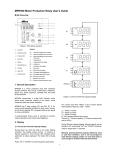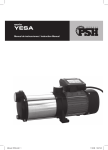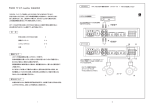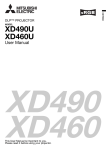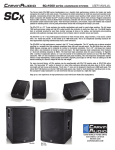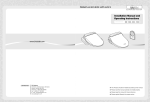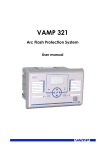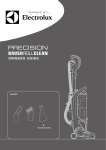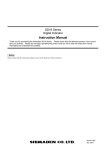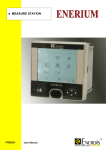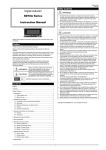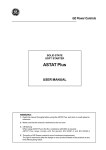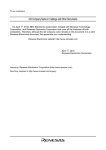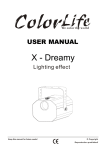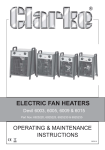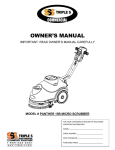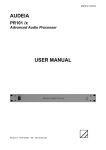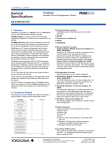Download User Manual
Transcript
MPR500 Motor Protection Relay User's Guide V1.3 Brief Overview h i a Motor Protection Relay b c t 6X I >> t >> I << t << t I o >> IL1 t o >> I S >> t Start t Stall IB d e CT SW f g IL2 Figure 1: Front panel overview a – Run LED Symbols b – Trip/Pickup LED t6X – Thermal overload time constant c – Thermal LED t>> – Short circuit/High set Overcurrent delay time d – Down key e – Up key f – Reset/Mode key g – Test key h – Data LED i – Function LED I>> – Short circuit/High set Overcurrent I< t< IL3 – Undercurrent – Undercurrent delay time – Unbalance t – Unbalance delay time I0> – Earth fault t0> – Earth fault delay time I0 IS>> – Prolonged starting/stall rotor tStart – Prolonged starting delay time tStall – Stall rotor delay time IB – Base/full load current CT – External current transformer ratio SW – Soft switch Thermal 1. General Description MPR500 is a motor protection relay that combines thermal overload, short circuit, undercurrent, unbalance, phase loss, phase sequence, lock/stall rotor and earth fault protections. Figure 2: Current and thermal capacity display MPR500 incorporates a 4-digit LED indicator which allows direct numerical readout of set values, actual measured value and system indication. For current more than 1000A, a dot is shown behind least significant digit. Eg: 1.25. = 1.25kA MPR500 has 2 relay outputs (R1 and R2). R1 is On under normal operating condition to allow motor running, and off during tripping. R2 is programmable to give signal in various conditions. IL1 - Phase 1 current IL2 - Phase 2 current IL3 - Phase 3 current I0 - Zero sequence/Earth fault current Thermal % - Thermal capacity % (Thermal overload tripping at 100%) A programmable binary input is provided to perform various operations upon binary input triggering. 2. Display During Thermal capacity display, thermal capacity can be cleared to 0% by pressing "UP" and "DOWN" simultaneously for longer than 1.5 seconds. 2.1 Current and Thermal Capacity Display During power up, when the relay is not under tripping condition, the display shows current in ampere or thermal capacity %. The Function LED indicates which parameter is being displayed. The Data LED showing value. Warning: Clearing thermal capacity effectively reset to cold start condition, user is not encouraged to clear thermal capacity unless it is sure that motor is cool enough to run/start within its thermal limit. Press “UP” or “DOWN” to scroll through the parameters. 1 2.2 Auto Scroll Current/Thermal Display When auto scroll is enabled, the display scrolls between currents and thermal reading every 10 seconds. To toggle auto scroll mode, press "UP" and "DOWN" simultaneously. Tripping History 1 t6X Thermal overload time constant 2.3 LED Display a) Run LED 2 I>> Short circuit Run LED shows the motor status. Refer to 3.2.1 Motor Starting. Off Motor stopping Blink Motor starting On Motor running 3 t>> Short circuit delay time 4 I<< Undercurrent 5 t<< Undercurrent delay time b) Trip LED Trip LED is normally off. During tripping pickup, where tripping delay is counting down, Trip LED blinks. Trip LED on during tripping. Off Normal Blink Pickup On Tripping Blink Thermal overload warning On Thermal overload tripping Thermal capacity high, R1 off 7 t Unbalance delay time 9 t0 >> Earth fault delay time A IS >> Prolonged starting / stalled rotor Thermal LED blinks when motor current is more than 105% of IB. Thermal LED on during thermal overload tripping, and when thermal capacity is more than 40% after overload tripping (in which R1 is off, motor not allowed to start) Normal Unbalance 8 I0 >> Earth fault c) Thermal LED Off 6 b t Start >> Prolonged starting delay time c t Stall >> Stalled rotor delay time d IB Base/full load current E External CT ratio F1 Auto/Manual Reset 3. Settings and Protection Features 3.1 Setting Display F2 Binary input When the relay is not under tripping condition, pressing "RESET/MODE" will scroll through various settings. Function LED showing number or alphabet to indicate which setting is being view as shown in Figure 3. Table 1 gives description of each setting. F3 Relay 2 function F4 Phase Sequence/ Phase Loss option Tip: To quickly jump back to current/thermal display during setting display, press and hold "RESET/MODE" for 1.5 second. F5 Frequency Figure 3: Display mode when pressing Reset/Mode 2 3.2 Programming Setting Step 1: Press "RESET/MODE" until the Function LED shows the required setting. Step 2: Press "UP" and "DOWN" simultaneously to enter programming mode. The Function LED blinks to indicate the relay is in programming mode. Step 3: Press "UP" or "DOWN" to change the value. Step 4: To save the new value, press "UP" and "DOWN" simultaneously again. Programming mode exits, function LED stop blinking. To exit programming mode without saving, press "RESET/MODE" once Setting Function Setting Range 1 t6X Thermal overload time constant 1-40s. In steps of 0.1s for 1-10s, in steps of 1s for 10-40s. Time constant for thermal overload 2 I>> Short circuit off, 2-12 x IB. In steps of 1 x IB Short circuit setting in multiples of IB 3 t>> Short circuit delay time 0-25s. In steps of 0.1s for 0-10s, in steps of 1s for 10-25s Delay time for short circuit 4 I<< Undercurrent off, 20-90% of IB . In steps of 1% Undercurrent setting in % of IB 5 t<< Undercurrent delay time 0-60s. In steps of 0.1s for 0-10s, in steps of 1s in 10-60s. Delay time for undercurrent Unbalance off, 10-50%. In steps of 1% Phase unbalance setting in % Unbalance delay time 0-25s. In steps of 0.1s for 0-10s, in steps of 1s for 10-25s. Delay time for phase unbalance 6 Description 7 t 8 I0 >> Earth fault off, 10-60% of IB . In steps of 1% Earth fault setting in % of IB 9 t0 >> Earth fault delay time 0-25s. In steps of 0.1s for 0-10s, in steps of 1s for 10-25s. Delay time for earth fault A IS >> Prolonged starting /stalled rotor off, 2-12 x IB. In steps of 0.1 x IB Prolonged starting/stalled rotor setting in multiples of IB b tStart >> Prolonged starting delay time 0-60s. In steps of 0.1s for 0-10s, in steps of 1s for 10-60s. Delay time for prolonged starting c tStall >> Stalled rotor delay time 0-60s. In steps of 0.1s for 0-10s, in steps of 1s for 10-60s. Delay time for stalled rotor d IB Base/full load current 2-10A Base/full load current of motor E External CT ratio 1-800:1 External CT ratio. 1=direct. F1 Auto/Manual Reset 0 - Manual reset 1- Auto reset Manual or auto reset of tripping Thermal overload is always auto reset F2 Binary input 0 - Block relay 1 1 - Reset tripping 2 - Instant tripping Setting for binary input F3 Relay 2 function 0 - On any tripping Relay 2 function 1 - On thermal tripping 2 - On thermal warning F4 Phase sequence (PS)/ phase loss (PL) option 0 - PS and PL off 1 - PS on 2 - PL on 3 - PL and PS on Phase sequence and phase loss option F5 Frequency 50 or 60Hz Nominal value of network frequency Table 1: Description of settings 3 3.2.1 Motor Status where: Run LED shows the motor status. Upon power on the relay, if there is no tripping, Relay 1 turns on. Imax is the maximum phase current among the 3 phases. Imin is the minimum phase current among the 3 phases. If motor current is more than 1.1 x IB, motor is considered starting, Run LED blinks. If motor current is less than 1.05 x IB, motor is running, Run LED on. Motor is stopping when motor current drops below 0.1 x IB. Tripping takes place when unbalance value is more than unbalance setting % for longer than unbalance delay. It can be disabled by setting unbalance delay to 'off'. Figure 4: Thermal tripping curve If motor starts abnormally for longer than 60s, Run LED stops blinking and turns off, Relay 1 also turns off. This condition reset when motor current drops below 0.1 x IB. time 2hour 3.2.2 Thermal Overload 1hour The protection is based on mathematical model of motor thermal image. The thermal capacity is calculated continuously when motor is starting, overloading or even after tripping. Tripping takes place when the thermal capacity of the motor reaches 100%. This could happen when the motor current is higher than 1.05 x IB. After tripping a new start is not allowed until the motor cools down to less than 40% of thermal capacity. Thermal capacity can be cleared to 0% by pressing "UP" and "DOWN" simultaneously for longer than 1.5 seconds during thermal capacity display. 30min 20min 10min 5min 3min 2min Warning: Clearing thermal capacity effectively reset to cold start condition, user is not encouraged to clear thermal capacity until motor is cool enough to start/run within its thermal limit. 1min t6x 40s 30s 40s 30s 20s 20s 10s 10s 5s 5s 3s 2s 3.2.3 t6X Thermal overload Time Constant 1s t6X sets the themal overload time constant (heating constant), which is the maximum period of time when motor current is allowed to reach a 6 x IB. Cooling constant time is defined as 4 times of heating constant time and is applicable when motor current is less than 0.2 x IB. Refer to the thermal tripping curve on Figure 4. 1 1s 2 3 4 5 6 (a) With 0% thermal capacity (cold start) I/IB time 2hour 3.2.4 Short Circuit 1hour This protection is to trip the relay quickly when high current is detected due to short circuit. I>> is normally set higher than motor starting current to avoid false tripping during motor starting and t>> is set to very short duration. 30min 20min 10min 5min 3min Tripping takes place when any phase of motor current is larger than I>> for longer than t>>. It can be disabled by setting t>> to 'off'. 2min 1min 40s 30s 3.2.5 Undercurrent t6x 10s 40s 30s 20s 5s 10s 20s Undercurrent protection is activated when average motor current is larger than 0.1 x IB. Tripping takes place when average motor current is smaller than I<< for longer than t<<. It can be disabled by setting t<< to 'off'. 3s 5s 2s 3.2.6 Unbalance Unbalance is calculated as: 2s 1.05 Imax - Imin Imin 1.05 1s X 100 % 1 2s 1s 2 3 4 (b) With prior 50% thermal capacity 4 5 6 I/IB 3.2.7 Phase Loss 3.2.12 External CT Ratio Phase loss fault is detected when average motor current is larger than 0.28 x IB but any phase current is less than 0.1 x IB. Tripping takes place in less than 120ms when phase loss is detected. The CT ratio shall be set accordingly for the display to show primary current. For example when using 150/5 CT, set the value to: External CT ratio = 3.2.8 Phase Sequence 150 = 30 5 3.2.13 Manual or Auto Reset Phase sequence fault is detected when the phase sequence in any 2 or all the phases are reversed. Tripping takes place in less than 120ms when phase sequence fault is detected. Phase loss and phase sequence protection can be enabled and disabled separately. Refer to 3.2.16 Phase sequence / phase loss option The relay can be set to manual or auto reset when the relay trips. Resetting of relay is allowed when the tripping condition cleared. Manual reset is performed by pressing the "RESET/MODE" (or using binary input if it is configured as 1 - Reset trip). Thermal overload is always auto reset. 3.2.9 Prolonged Starting and Stalled Rotor 3.2.14 Binary Input For prolonged starting and stalled rotor there is one IS>> setting and separate delay time setting for each protection. IS>> shall be set below the motor starting/ stalled current. These protections are useful when thermal overload protection is not fast enough to protect the motor during stalling. The binary input is a dry contact input that can be configured to perform various functions. Delay time for prolonged starting, tStart>> shall be set longer than specified motor starting time. Tripping takes place when any phase current is larger than IS> for longer than tStart during motor starting. 2 - Instant tripping The input will generate a tripping condition. Refer to 4.4 Binary Input Tripping. 0 - Block relay 1 The input, when triggered, will force relay 1 off. 1 - Reset tripping The input is used to manually reset a tripping. 3.2.15 Relay 2 Delay time for stalled rotor, tStall>> is activated upon completing the motor starting. Tripping occurs when any phase current is larger than IS>> for longer than tStall>> during motor running. The relay 2 output can be configured to turn on in these conditions: 0 - On any tripping Relay 2 on during any tripping. Both protections can be disabled by setting IS>> to 'off'. To disable only one of the protection, set the respective delay time for the protection to be disabled to much longer than specified. 1 - On thermal tripping Relay 2 on during thermal tripping only. 2 - On thermal warning Relay 2 on when motor current is more than 1.05 x IB. 3.2.10 Earth Fault 3.2.16 Phase sequence / phase loss option Earth fault protection is based on zero sequence current calculation. Tripping takes place when the current is larger than earth fault setting in % of IB for longer than t0>. It can be disabled by setting t0>> to 'off'. Phase sequence and phase loss detection can be on (enabled) and off (disabled) separately. 0 - Phase sequence and phase loss off 1 - Phase sequence on 2 - Phase loss on 3 - Phase sequence and phase loss on 3.2.11 Base Current Base current is the motor full load current. The range of setting is model dependent. 3.2.17 Frequency The formula is: IB = Motor full load current X Nominal value of the network frequency. Select either 50 or 60 Hz. 1 CT ratio For example to use the relay with motor that has full load current of 138A, using external CT of 150/5, IB = 138 X 5 = 4.6A 150 5 4. Tripping 4.1 Tripping Display 4.2 Tripping Reset During tripping, Trip LED on, Thermal LED also on during thermal overload tripping. Function LED and Data LED blinks showing tripping current or source as shown below: During tripping condition, press "RESET/MODE" to reset, the relay will reset if condition permits. If relay is set to auto reset, the relay will reset automatically if the tripping condition is cleared with a 5% hysteresis. Trip LED Thermal Function Data LED LED LED 4.3 Tripping Test Description On On t oL On Off 2 tripping current Short circuit tripping On Off 4 tripping current Undercurrent tripping On Off 6 Ub Unbalance tripping On Off 6 PS Phase sequence error tripping On Off 6 PL Phase loss tripping On Off 8 tripping current Earth fault tripping On Off A tripping current Prolonged starting/Stalled rotor tripping On On t ESt Trip Test On Off t riP Binary input tripping Press and hold "TEST" for 3.5 seconds to simulate a tripping condition, Trip LED blinks when "TEST" is pressed. During Test Tripping, "tESt" blinks, R1 off and R2 on if set to "On any tripping". Press "RESET/MODE" to reset. Tripping Test is disabled when motor is starting/running. Thermal Overload tripping 4.4 Binary Input Tripping When Binary input is set to 2 - Instant tripping, binary input will generate a tripping condition. "triP" will blink, R1 off and R2 on if set to "On any tripping". Press "RESET/MODE" to reset. If relay is set to auto reset, the relay will reset after the input is normal for 1s. 4.5 Tripping History Display Table 2: Tripping display During Current/Thermal display, press "RESET/MODE" to jump to Tripping History Display. Display shows the previous tripping status with a 'dot' blinking at Function LED. To clear tripping history, press "UP" and "DOWN" simultaneously. 5. Typical Application Diagram L3 L2 L1 F1 F2 L F4 F2 F1 F3 MPR 500 K1 9 10 Aux R1 13 Binary input M 16 9 Aux 1 L N 10 2 3 NO 11 3 NO 4 NC 4 NC 5 COM 6 COM 6 R2 L N 5 14 15 1 2 11 12 MPR 500 K1 7 8 12 S2 Stop COM COM Start S1 NC 13 14 K1 Binary input NO H1 Block R1/ Reset/ Trip R1 M K1 N 15 R2 16 Block R1/ Reset/ Trip S2 Stop S1 Start 7 NC 8 NO H1 K1 K1 N 3-Phase Motor Single-Phase Motor * Figure 5: Example of application * To use MPR500 for single-phase protection, Io>> Earth fault, Phase sequence and phase loss protection should be set to off. 6 6. Techinical Data SETTING RANGES Thermal Overload time constant, t6X Short circuit, I>> Short circuit delay time, t>> Undercurrent, I<< Undercurrent delay time, t<< Unbalance, Unbalance delay time, t Earth fault, I0>> Earth fault delay time, t0>> Phass loss Phase sequence Prolonged starting/stalled rotor, IS Prolonged starting delay time, tStart Stalled rotor delay time, tStall : : : : : : : : : : : : : : 1 – 40s. In steps of 0.1s for 1-10s, in steps of 1s for 10-40s off, 2 – 12 x IB. In steps of 1 x IB 0 – 25s. In steps of 0.1s for 1-10s, in steps of 1s for 10-25s off, 20 – 90% of IB. In steps of 1% 0 – 60s. In steps of 0.1s for 1-10s, in steps of 1s for 10-60s off, 10 – 50%. In steps of 1% 0 – 25s. In steps of 0.1s for 1-10s, in steps of 1s for 10-25s off, 10 – 60% of IB. In steps of 1% 0 – 25s. In steps of 0.1s for 1-10s, in steps of 1s for 10-25s <120ms <120ms off, 2 – 12 x IB. In steps of 0.1 x IB 0 – 60s. In steps of 0.1s for 1-10s, in steps of 1s for 10-60s 0 – 60s. In steps of 0.1s for 1-10s, in steps of 1s for 10-60s : : : : 2-10A 50 or 60Hz <0.3VA at rated current Continuous: 2 x maximum rated For 30s: 6 x maximum rated For 1s: 10 x maximum rated CT RATINGS Rated current Rated frequency Burden Thermal withstand CASE DIMENSION BINARY INPUT Rated input voltage 9 6 mm : 12V (Supplied internally) AUXILIARY SUPPLY Supply frequency Maximum power consumption : 85 ~ 265 V AC 110 ~ 370 V DC : 50 or 60 Hz : 3 VA typical 9 6 mm Model MPR 500-240A Fr o n t CONTACTS Contact arrangement Contact rating Contact material Operating time Expected electrical life Expected mechanical life : : : : : : Change-over 5A, 250V AC (cosf = 1) Silver alloy 15ms max 100,000 operations at rated current 5 x 106 operations 110mm 100mm INDICATORS Run Trip/Pickup Thermal : Green indicator : 7-segment display and red indicators : Yellow indicator 90mm ENVIRONMENTAL CONDITIONS MECHANICAL Mounting Front panel Approximate weight : -5ºC to +55ºC : 56 days at 93% RH and 40ºC non-condensing : Panel mounting : Standard DIN 96 mm x 96mm : 0.75kg 90mm Temperature Humidity Figure 6 7







